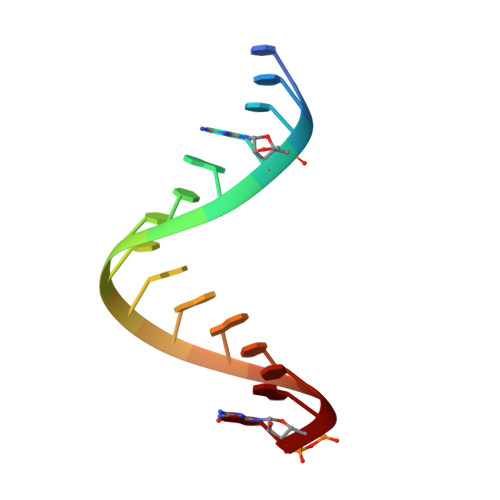Prebiotically Plausible "Patching" of RNA Backbone Cleavage through a 3'-5' Pyrophosphate Linkage.
Wright, T.H., Giurgiu, C., Zhang, W., Radakovic, A., O'Flaherty, D.K., Zhou, L., Szostak, J.W.(2019) J Am Chem Soc 141: 18104-18112
- PubMed: 31651170
- DOI: https://doi.org/10.1021/jacs.9b08237
- Primary Citation of Related Structures:
6U6J - PubMed Abstract:
Achieving multiple cycles of RNA replication within a model protocell would be a critical step toward demonstrating a path from prebiotic chemistry to cellular biology. Any model for early life based on an "RNA world" must account for RNA strand cleavage and hydrolysis, which would degrade primitive genetic information and lead to an accumulation of truncated, phosphate-terminated strands. We show here that cleavage of the phosphodiester backbone is not an end point for RNA replication. Instead, 3'-phosphate-terminated RNA strands can participate in template-directed copying reactions with activated ribonucleotide monomers. These reactions form a pyrophosphate linkage, the stability of which we have characterized in the context of RNA copying chemistry. The presence of free magnesium cations results in cleavage of the pyrophosphate bond within minutes. However, we found that the pyrophosphate bond is relatively stable within an RNA duplex and in the presence of chelated magnesium. We show that, under these conditions, pyrophosphate-linked RNA can act as a template for the polymerization of ribonucleotides into canonical 3'-5' phosphodiester-linked RNA. We suggest that primer extension of 3'-phosphate-terminated RNA followed by template-directed copying represents a plausible nonenzymatic pathway for the salvage and recovery of genetic information following strand cleavage.
Organizational Affiliation:
Howard Hughes Medical Institute, Department of Molecular Biology, and Center for Computational and Integrative Biology , Massachusetts General Hospital , 185 Cambridge Street , Boston , Massachusetts 02114 , United States.















